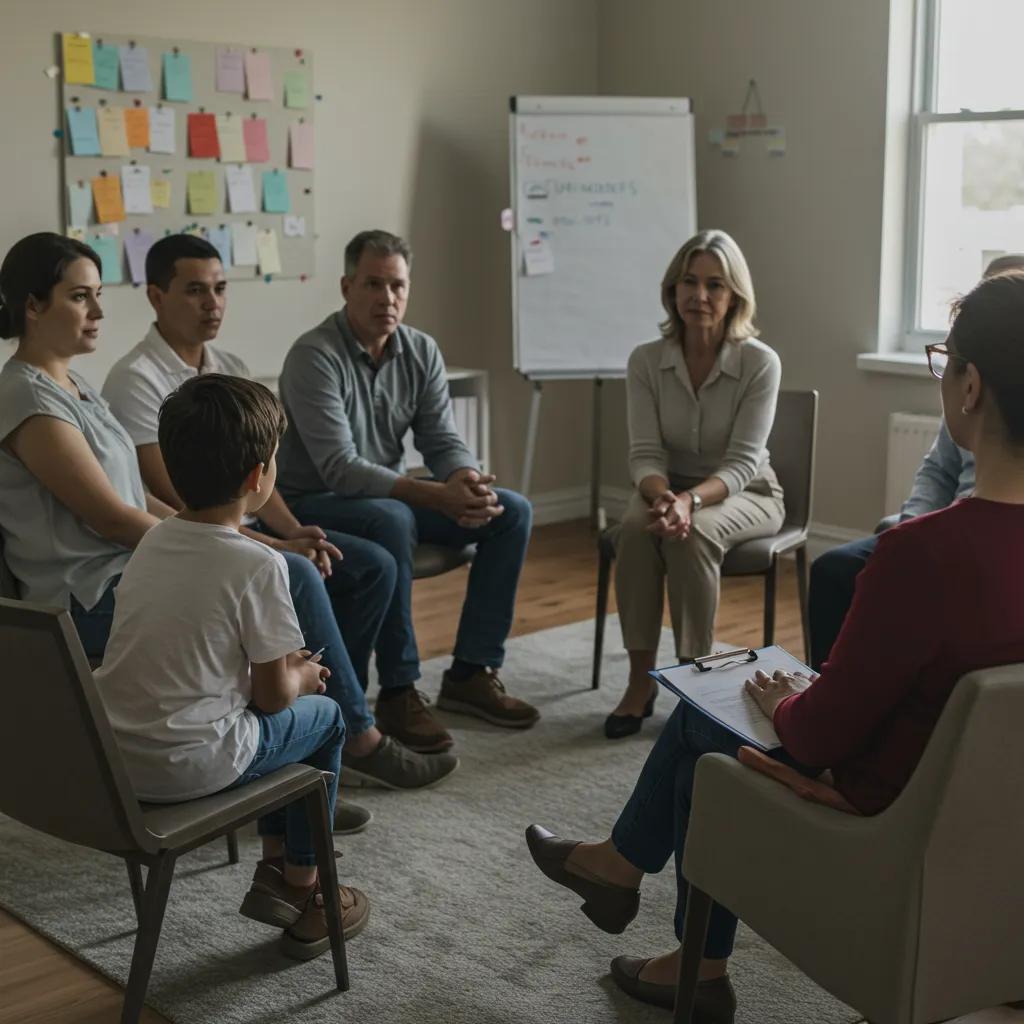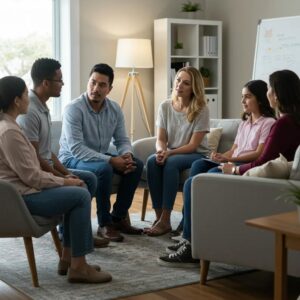Why Families Benefit from Group Sessions: Key Advantages of Family Group Therapy
Family group therapy is a structured form of psychotherapy where multiple family members meet together with one or more clinicians to address relational patterns, communication problems, and shared coping needs. This article explains why families benefit from group sessions, how those benefits arise through specific therapeutic mechanisms, and what families can expect when they participate. Readers will learn the primary advantages—improved communication, conflict resolution, stronger emotional support, and resilience-building—plus practical exercises, stepwise tools, and how family group therapy fits into residential treatment.
Many families struggle with repeated misunderstandings, caregiving stress, or relapse cycles; group sessions provide a safe, facilitated setting to practice new behaviors and create sustainable aftercare plans. The guide maps core benefits, communication techniques, conflict-resolution strategies, bonding mechanisms, coping skills instruction, residential integration with Revival Mental Health, and common questions families ask when starting group therapy.
What Are the Main Benefits of Family Group Therapy for Families?
Family group therapy delivers multiple interrelated benefits by changing interaction patterns, teaching skills, and creating shared meaning across family members. In practice, sessions focus on communication training, structured problem-solving, mutual validation, and rehearsal of coping strategies so that change is both learned and practiced in a social context. These mechanisms produce outcomes such as fewer misunderstandings, reduced conflict escalation, stronger caregiving coordination, and improved relapse prevention when addressing conditions like PTSD, anxiety, depression, and bipolar disorder. Clinical formats typically blend psychoeducation, role-play, and skills coaching to link therapist guidance with real-time family interaction, ensuring lessons translate into daily life. Below is a concise list of primary benefits families can expect from regular group sessions.
Family group therapy provides the following core benefits:
- Improved communication through structured sharing and active listening practice.
- Enhanced conflict resolution using therapist-guided problem-solving and boundary-setting.
- Strengthened emotional support and reduced isolation via shared experience and validation.
- Development of coping skills and relapse-prevention strategies practiced as a unit.
The table below summarizes how specific mechanisms lead to measurable outcomes for families, creating a compact reference for clinicians and family members preparing to join group sessions.
| Benefit | Mechanism | Outcome |
|---|---|---|
| Communication | Active listening practice and structured turn-taking | Fewer misunderstandings and clearer expectations |
| Conflict resolution | Therapist-led problem-solving and goal setting | Reduced escalation and collaborative solutions |
| Emotional support | Peer validation and shared narratives | Lower isolation and increased caregiving cohesion |
| Coping skills | CBT/DBT skill rehearsal and contingency planning | Improved relapse prevention and home-based maintenance |
This mapping shows how concrete therapeutic techniques produce observable family-level improvements, and it underscores why families often report better day-to-day functioning after sustained participation in group sessions. The next section explains precisely how communication changes during these groups.
How Does Family Group Therapy Improve Communication Within Families?

Family group therapy improves communication by turning abstract guidance into practiced behaviors that family members rehearse in-session with clinician feedback. Therapists introduce structured sharing formats, time-limited turn-taking, and reflection prompts so participants can hear and paraphrase one another without defensive interruption. Role-plays and scripted prompts reduce ambiguity, teach clearer expression of needs, and help family members replace blaming language with curiosity and specific requests. Practicing these skills in the group accelerates habit change at home because family members receive immediate corrective feedback and model alternatives they can replicate between sessions. Improved communication then becomes a foundation for addressing deeper conflicts and building collaborative problem-solving.
In What Ways Does Group Therapy Strengthen Family Bonds and Support Systems?
Group sessions strengthen bonds by normalizing individual struggles and creating a collective framework for support that replaces shame with mutual validation. When families share stories and observe others’ recovery efforts, they gain perspective and empathy that reduce feelings of isolation and blame. Therapists structure activities that encourage mutual caregiving plans—such as shared routines, check-ins, and relapse contingency agreements—which convert emotional validation into practical support. Over time, the repeated experience of being heard and of successfully supporting a loved one rebuilds trust and clarifies roles, creating a more unified approach to care. These strengthened bonds then make coordinated aftercare and long-term recovery planning more feasible and sustainable.
How Does Family Group Therapy Help Develop Healthy Coping Skills?
Family group therapy teaches both individual and collective coping techniques so that families can respond adaptively to stressors together rather than defaulting to maladaptive patterns. Clinicians commonly introduce CBT tools for reframing unhelpful thoughts, DBT-based distress-tolerance skills for urgent crises, and concrete behavioral routines like scheduled check-ins and grounding exercises. Families practice these skills in-session and assign homework experiments to test strategies at home, which facilitates generalization outside therapy. By building a shared toolkit and clear contingency plans, family members can support one another during high-risk moments and reduce the likelihood of relapse or crisis. The following list highlights typical coping strategies taught in group formats.
Common coping strategies taught in family group therapy include:
- Mindfulness and grounding exercises practiced daily as a family check-in.
- Reframing and cognitive tools to interrupt unhelpful thought cycles.
- Distress-tolerance skills and short-term safety plans for acute stress.
These strategies, practiced collectively, strengthen individual resilience while improving the family’s capacity to respond supportively during difficult moments. The following section examines the communication mechanics that underpin many of these gains.
How Does Family Group Therapy Facilitate Improved Communication and Understanding?
Family group therapy facilitates improved communication by establishing clear rules, teaching active listening, and guiding families through perspective-taking exercises that reduce reactivity. At the start of sessions clinicians set norms—such as confidentiality, time-limited sharing, and noninterruptive listening—that create psychological safety for honest exchanges. Structured exercises require paraphrasing, reflective statements, and corrective feedback so that misunderstandings are corrected in real time, which reduces the accumulation of resentment and misinterpretation. Over successive sessions, these communication practices become procedural memory for family members, producing a durable shift in how they speak to and about one another. Below are practical communication practices used in group sessions to accelerate understanding.
- Paraphrase and reflect: Each listener restates the speaker’s point before responding to ensure accurate understanding.
- I-statements: Family members describe their feelings and needs without assigning blame.
- Time-limited turns: Enforced turn-taking prevents interruptions and reduces escalation.
These practices are most effective when therapists scaffold them with role-plays and homework assignments that translate in-session learning into everyday routines, which leads into a closer look at active listening skills.
What Are Active Listening Skills in Family Group Sessions?
Active listening in family group sessions consists of explicit behaviors—paraphrasing, reflecting emotion, and checking for understanding—that reduce misinterpretation and foster empathy. Therapists teach mini-exercises where one person speaks for a fixed period while others practice paraphrasing the content and naming the emotion conveyed, which highlights differences between facts and interpretations. Nonverbal cues, such as eye contact and open posture, are also addressed to reinforce attentiveness, and clinicians may coach family members to notice and pause automatic defensive reactions. Repeated practice in a safe setting helps family members replace reactive replies with centered, curiosity-driven responses that improve long-term communication. The next subsection explains how families can express emotions constructively without escalating conflict.
How Can Families Express Emotions Constructively During Group Therapy?
Constructive emotional expression in group therapy relies on rules, scripting, and therapeutic mediation that channel intense feelings into productive exchanges. Clinicians introduce I-statements and brief scripts—like “I feel X when Y happens, and I need Z”—to reduce blaming language and increase clarity of requests. Ground rules such as timeouts, agreed pauses, and therapist-led containment reduce the risk of escalation, and therapists coach repair attempts when ruptures occur to restore connection. Families practice these scripts during role-plays and receive feedback on tone, content, and timing so that emotional honesty becomes safer and more effective at home. Practicing repair behaviors in session naturally leads to greater empathy-building, which we cover next.
How Does Building Empathy Enhance Family Communication?
Building empathy enhances communication by shifting conversations from accusation to understanding, which opens pathways for collaborative problem-solving. Empathy exercises—such as perspective-taking prompts where each member summarizes the other’s likely motives—help reveal underlying needs that fuel conflict, making it easier to design mutually acceptable solutions. Validation techniques taught in groups show families how to acknowledge feelings without endorsement of harmful behaviors, which reduces defensiveness and increases willingness to cooperate. As empathy becomes more habitual, families report fewer reactive cycles and more intentional conversations, creating the conditions needed for effective conflict resolution covered in the next section.
How Does Family Group Therapy Support Conflict Resolution and Problem-Solving?
Family group therapy supports conflict resolution by teaching families to distinguish surface disagreements from core recurring patterns, then applying structured problem-solving to address root causes. Clinicians often use genogram mapping and interaction cycles to identify repeating triggers and systemic roles that perpetuate conflict, which clarifies where interventions will be most effective. Once core conflicts are identified, therapists lead collaborative goal-setting, brainstorm interventions, and assign small experiments to test solutions in the home environment. This stepwise approach—identify, prioritize, plan, practice, review—reduces escalation and increases accountability while preserving relationships. Below is a table contrasting healthy versus unhealthy conflict resolution methods and the therapist techniques used to shift patterns.
| Resolution Method | Therapist Role/Technique | Expected Result |
|---|---|---|
| Calm problem-solving | Facilitate structured dialogue and goal-setting | Collaborative solutions and repair attempts |
| Boundary-setting | Coach assertive communication and limits | Reduced recurrence of triggering interactions |
| Avoidance or withdrawal | Identify avoidance patterns and encourage engagement | Short-term relief but long-term unresolved conflict |
| Escalation and contempt | Interrupt cycles and teach de-escalation skills | Reduced hostility and restored safety |
This comparison highlights how therapeutic techniques replace harmful patterns with sustainable practices that support recovery and family functioning. The next subsection outlines specific strategies for uncovering core family conflicts.
What Strategies Help Identify and Address Core Family Conflicts?
Clinicians use assessment tools—such as genograms, interaction mapping, and targeted interviews—to surface the historical patterns and triggers that maintain conflict across generations. Genograms visualize family relationships and recurring issues, while interaction mapping traces sequences of behavior that escalate tension in real time, enabling therapists to pinpoint leverage points for intervention. Therapists also ask clarifying questions to separate immediate complaints from long-standing roles or unaddressed hurts, which helps prioritize which issues to tackle first. By identifying underlying needs and patterns, families can move from symptom-focused fixes to strategic changes that prevent repeated crises. Once conflicts are clarified, therapists guide families through collaborative problem-solving steps.
How Can Families Collaborate to Solve Problems in Therapy Sessions?
Therapist-facilitated collaboration uses stepwise problem-solving: define the problem, set a shared goal, brainstorm options, agree on small experiments, and schedule review sessions to evaluate outcomes. Therapists ensure equitable participation by allocating speaking time, prompting quieter members, and translating emotional statements into behavioral goals that can be tested. Small, time-limited experiments—such as a one-week communication contract or a new nightly check-in—allow families to trial solutions without high stakes, and follow-up in subsequent sessions reinforces learning and accountability. Consistent review cycles help families refine strategies and scale what works, which reduces conflict recurrence and strengthens long-term cooperation. Below is a short list of the operational steps families follow in this collaborative model.
Key steps for in-session collaborative problem-solving:
- Define the shared problem in observable, specific terms.
- Set a measurable, short-term goal agreed by all members.
- Brainstorm and select one small experiment to try at home.
- Review results together and adjust the plan based on data.
These operational steps translate therapeutic insight into concrete behavior changes, and the next brief subsection contrasts healthy and unhealthy conflict methods for clarity.
What Are Healthy vs. Unhealthy Conflict Resolution Methods?
Healthy conflict methods prioritize clear boundaries, calm problem-solving, and timely repair attempts that restore connection after ruptures, while unhealthy methods rely on avoidance, escalation, contempt, or passive aggression that erode trust. Therapeutic alternatives taught in groups include structured repair scripts, timeouts with re-engagement plans, and negotiated boundary agreements that replace implicit rules with explicit, mutually understood practices. Unhealthy patterns are addressed by increasing awareness, modeling alternative responses, and assigning in-session rehearsals so new habits can displace old ones. Families who adopt healthy methods report fewer crises and more reliable caregiving coordination, which supports recovery and sustained home functioning. With conflict tools in place, families can better foster emotional bonds and sustained support, a topic explored next.
In What Ways Does Family Group Therapy Strengthen Family Bonds and Emotional Support?
Family group therapy strengthens bonds by combining validation, shared ritual formation, and coordinated caregiving planning that turn individual gains into collective resilience. Through repeated sessions families learn a shared language for recovery, agree on routines and responsibilities, and model supportive responses that become default behaviors. Peer validation within the group reduces shame and normalizes difficult experiences, while practical coordination—such as assigning specific support tasks or establishing relapse plans—converts empathy into concrete assistance. Over time, these processes create a unified family front that sustains treatment gains and lowers the risk of miscommunication-driven relapse. The following subsection examines how shared experiences produce validation and emotional safety.
How Do Shared Experiences in Group Sessions Provide Emotional Validation?
Shared experiences in group sessions create emotional validation by allowing family members to hear others describe similar struggles, which normalizes feelings and reduces internalized blame. When multiple families or family members recount parallel challenges, isolation diminishes and the emotional burden is redistributed across a supportive network, making coping feel more manageable. Therapists facilitate exercises that surface common themes, encouraging participants to name and accept difficult emotions while modeling compassionate responses. This normalization not only reduces shame but also strengthens willingness to participate in joint problem-solving and caregiving activities. Validation gained from shared experiences therefore becomes a platform for coordinated action and recovery planning.
What Role Does Creating a Unified Family Front Play in Recovery?
A unified family front supports recovery by aligning expectations, clarifying roles, and maintaining consistent responses to triggers, which reduces mixed signals that often undermine treatment gains. Family group therapy helps members negotiate shared strategies for boundary enforcement, medication adherence support, outpatient follow-up, and emergency plans so that everyone understands their responsibilities. This coordination reduces the burden on individual caregivers, distributes tasks more equitably, and increases predictability for the person in recovery. A clear, unified approach also makes relapse signals easier to detect and respond to early, shortening crises and preserving progress. With these coordinated supports in place, families transition more confidently from intensive treatment to sustainable home-based care, leading into the next topic on coping mechanisms.
How Does Family Group Therapy Help Families Develop Healthy Coping Mechanisms?
Family group therapy builds healthy coping by teaching evidence-based individual techniques and creating collective strategies that families practice together until they become routine. Clinicians introduce CBT approaches to reframe maladaptive thoughts, DBT skills for emotion regulation and distress tolerance, and behavioral plans that structure supportive routines and contingency responses. Families rehearse these strategies in session with therapist coaching and then implement small experiments at home to test effectiveness, fostering both skill acquisition and accountability. Over repeated practice, coping techniques generalize across situations, increasing resilience and lowering the frequency and severity of crises. The next subsection lists specific individual and collective coping strategies commonly taught in group sessions.
What Individual and Collective Coping Strategies Are Taught in Group Sessions?
Group sessions typically teach a blend of individual skills—such as mindfulness, breathing exercises, and cognitive reframing—and collective strategies like scheduled check-ins, shared emergency plans, and role-based support assignments. CBT tools help individuals identify and shift unhelpful thought patterns that fuel emotional reactivity, while DBT techniques provide concrete distress-tolerance tactics for acute episodes. Collectively, families create contingency plans specifying steps to take during warning signs and designate who will handle logistics, which reduces ambiguity during high-stress periods. Practicing these strategies together improves consistency and ensures that coping is reinforced across family contexts, which then supports resilience-building covered next.
How Does Family Group Therapy Build Resilience Among Family Members?
Family group therapy builds resilience by combining skill rehearsal, mutual encouragement, and accountability structures that help family members recover more quickly from setbacks. Repeated practice of coping skills in a social setting increases confidence and habituation, while peer support sustains motivation during difficult periods. Therapists emphasize small, achievable experiments and celebrate incremental successes to reinforce adaptive behavior, which strengthens self-efficacy across family roles. As families internalize these practices, they create a durable support system that mitigates stressors and accelerates recovery, paving the way for smoother transitions into residential programs or community-based aftercare addressed next.
How Is Family Group Therapy Integrated into Residential Treatment at Revival Mental Health?
In residential settings, family group therapy is integrated as a complementary component that aligns family training with the patient’s immersive clinical treatment, producing stronger outcomes through coordinated care. Revival Mental Health in Orange County offers Family Group Therapy as part of comprehensive residential programming, pairing family sessions with individual CBT and DBT and providing personalized treatment plans and 24/7 clinical support from doctorate- or master’s-level clinicians within an intimate therapy environment. This integration allows families to practice newly learned skills while the individual remains in a structured setting, creating safer opportunities to confront triggers and rehearse caregiving strategies under clinician supervision. The integration also facilitates clear aftercare planning and smoother transitions to home-based supports after discharge.
Before the table below, clinicians should know this mapping clarifies what residential components provide and how each contributes to family and patient benefits.
| Program Component | What It Provides | Benefit to Family and Patient |
|---|---|---|
| 24/7 clinical support | Continuous monitoring and crisis management | Stabilizes acute symptoms and reassures families |
| Doctorate/master’s-level clinicians | Advanced clinical assessment and therapy delivery | High-quality, personalized interventions and family education |
| CBT/DBT integration | Skills training across individual and family sessions | Consistent application of coping strategies and relapse prevention |
| Family Group Therapy | Structured family sessions and psychoeducation | Improved communication, coordinated aftercare, and stronger home support |
This factual mapping explains how residential elements work together to maximize family engagement and recovery outcomes without overstating program specifics beyond available information. The next subsections outline holistic benefits and preparation for aftercare in residential contexts.
What Are the Holistic Benefits of Combining Family Therapy with Residential Care?
Combining family therapy with residential care creates a holistic treatment ecosystem where skills are taught, supervised, and generalized in a controlled environment that accelerates learning. The residential setting permits consistent practice of communication and coping strategies with clinician feedback available around the clock, enabling families to trial new behaviors without the immediate pressures of home life. Integrated case planning aligns individual goals with family objectives, ensuring everyone understands the recovery pathway and post-discharge expectations. This synergy shortens the learning curve for families and improves adherence to aftercare plans, which reduces the likelihood of early relapse and supports longer-term stabilization.
How Does Family Group Therapy Prepare Families for Long-Term Recovery and Aftercare?
Family group therapy prepares families for long-term recovery by producing concrete aftercare plans, clarifying roles, and linking families to outpatient resources and community supports for sustained maintenance. In-session planning includes identifying early warning signs, assigning responsibilities for follow-up care, and rehearsing how to activate supports if symptoms re-emerge, which increases readiness for the transition home. Clinicians also coordinate referrals to appropriate outpatient services and teach families how to sustain skills through scheduled check-ins and booster sessions. These preparations create realistic, practical steps that family members can implement immediately, improving continuity of care and reducing risks during the critical post-discharge period.
What Common Questions Do Families Have About Group Therapy Sessions?
Families commonly ask about levels of involvement, differences from individual therapy, and what to expect during initial sessions; answering these clearly helps reduce anxiety and sets realistic expectations. Clinicians should explain typical participation formats, confidentiality boundaries, and practical preparation steps so families enter sessions informed and ready to engage. Short, direct Q&A items below address these frequent concerns and reflect how programs that emphasize family involvement usually structure participation. After these brief answers, a short checklist outlines what families should bring and how to prepare for their first session.
Are Family Members Actively Involved in Group Therapy Sessions?
Yes—family members are often actively involved in group therapy through attendance, structured sharing, homework assignments, and ongoing follow-up; the degree of involvement varies by program and clinical needs. In many residential and outpatient models families participate in scheduled group sessions, take part in role-plays, and receive education about symptom management and communication strategies. Therapists may also assign family homework—such as practicing a communication script or implementing a check-in routine—to reinforce in-session learning. Families should expect to play an active, skills-focused role rather than a passive observational one, which helps the team plan realistic supports and responsibilities.
How Does Family Group Therapy Differ from Individual Treatment?
Family group therapy differs from individual treatment by focusing on relational patterns, shared dynamics, and systemic solutions rather than only on an individual’s internal experiences or symptom management. Individual therapy targets personal insight and skill-building, while family group therapy addresses how those skills are expressed and supported within the family system. Many effective programs integrate both approaches so that individual gains are reinforced by family-level changes, producing a complementary effect where individual treatment reduces symptom severity and family sessions improve the home environment. This combined approach enhances the likelihood that therapeutic gains will endure after treatment.
What Should Families Expect During Their First Group Therapy Session?
During a first group therapy session families can expect introductions, establishment of group norms, a brief clinical orientation, and low-risk exercises focused on sharing and assessment. Facilitators typically explain confidentiality parameters, set expectations for turn-taking and respectful communication, and conduct short activities to map concerns and goals. Families should bring a willingness to listen, basic information about recent history relevant to treatment, and openness to homework assignments that reinforce session learning. The initial session aims to create safety and a shared agenda, after which deeper skills training and collaborative problem-solving follow in subsequent sessions.
- Checklist for First Session Preparation: Bring a concise history of recent stressors, be prepared to share goals for therapy, and plan for a debrief with family members after the session.
- What to Expect Procedurally: The facilitator will set ground rules, outline session objectives, and conduct a short exercise to assess communication patterns.
- Follow-up Steps: Expect assigned practice tasks, scheduling of future sessions, and coordination with any concurrent individual or residential treatment plans.
This practical checklist helps families arrive prepared and reduces initial uncertainty, enabling faster engagement with therapeutic processes that strengthen communication, conflict resolution, and resilience.





